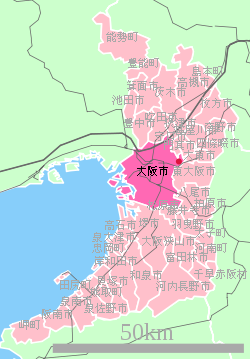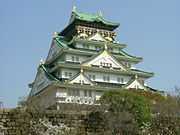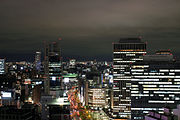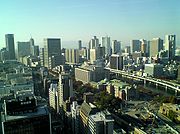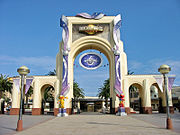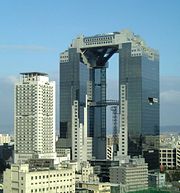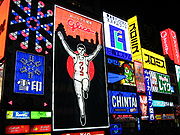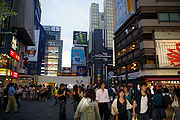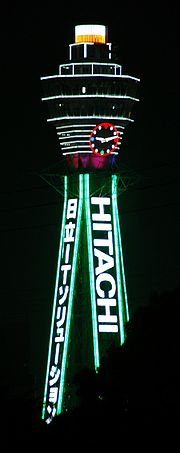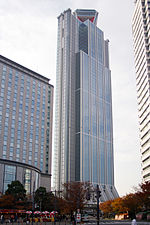
Osaka
About this schools Wikipedia selection
This content from Wikipedia has been selected by SOS Children for suitability in schools around the world. Sponsor a child to make a real difference.
| Osaka 大阪市 |
|||
|---|---|---|---|
| — City — | |||
|
|||
| Location of Osaka in Osaka | |||
| Country | Japan | ||
| Region | Kansai | ||
| Prefecture | Osaka | ||
| Government | |||
| • Mayor | Kunio Hiramatsu | ||
| Area | |||
| • Total | 222.11 km2 (85.76 sq mi) | ||
| Population ( January 1, 2007) | |||
| • Total | 2,636,257 (17,220,000 in Metropolitan Area) |
||
| • Density | 11,869/km2 (30,740/sq mi) | ||
| Time zone | Japan Standard Time ( UTC+9) | ||
| City symbols | |||
| - Tree | Sakura | ||
| - Flower | Pansy | ||
| Phone number | 06-6208-8181 | ||
| Address | 1-3-20 Nakanoshima, Kita-ku, Ōsaka-shi, Ōsaka-fu 530-8201 |
||
| Website | City of Osaka | ||
Osaka (大阪市 Ōsaka-shi) listen is a city in Japan, located at the mouth of the Yodo River on Osaka Bay, in the Kansai region of the main island of Honshū.
The city is the capital of Osaka Prefecture. Often dubbed the second city of Japan, Osaka was historically the commercial capital of Japan, and to date the heart of Japan's second largest (and the world's ninth largest) metropolitan area of Osaka-Kobe-Kyoto, whose population is 17,220,000.
A unique title that the city of Osaka holds is the first place in Japan for day to night population ratio of 141%, a depiction of Osaka's economic- and commerce-centric character. While at night time the population ranks third place in the country at 2.6 million, in daytime it surges to 3.7 million, second only after Tokyo.
Osaka is traditionally considered the "nation's kitchen" (天下の台所 tenka no daidokoro) or the gourmet food capital of Japan.
History
The beginnings - Kofun Period
Some of the earliest signs of habitation in the area of Osaka were found at the Morinomiya ruins (森の宮遺跡 Morinomiya iseki), with its shell mounds, including sea oysters and buried human skeletons from the 5 - 6th centuries BC. It is believed that what is today the Uehonmachi area consisted of a peninsular land, with an inland sea in the east. During the Yayoi Period, permanent habitation on the plains grew as rice farming became popular.
By the Kofun Period, Osaka developed into a hub port connecting the region to the western part of Japan. The large numbers, and the growing of the size of tomb mounds found in the plains of Osaka, are seen as evidence of political power concentrating, leading to the formation of a state.
Asuka and Nara Period
In 645, Emperor Kōtoku built his palace (難波長柄豊碕宮 Naniwa-no-nagara-no-toyosaki-no-Miya) in Osaka, making this area the capital (Naniwa-kyō). The area which now consists of Osaka city was called by this time Naniwa, a name which still exists as the names of districts in central Osaka as Naniwa (浪速) and Namba (難波). While the capital was moved to Asuka (in Nara Prefecture today) in 655, Naniwa has always been a vital connection, by land and sea, between Yamato (modern day Nara Prefecture), Korea, and China.
In 744, Naniwa was once again named capital by Emperor Shōmu. Naniwa ceased to be the capital in 745, when the Imperial Court moved back to Heijō-kyō (now Nara). The sea port function was gradually lost over to neighbouring lands by the end of Nara Period, but it remained a lively transit of river, channel and land transportation between Heian-kyō (Kyoto today) and other destinations.
Heian - Edo Period
In 1496, the Jōdo Shinshū Buddhist sect set up their headquarters in the heavily fortified Ishiyama Hongan-ji on top of the ruins of the old Naniwa imperial palace. In 1570, Oda Nobunaga started a siege of the temple that lasted for 10 years. The monks finally surrendered in 1580, the temple was razed, and Toyotomi Hideyoshi constructed Osaka Castle on its site.
Osaka was for a long time Japan's most important economic centre with a large percentage of the population belonging to the merchant class (see Four divisions of society). Over the course of the Edo period (1603–1867), Osaka grew into one of Japan's major cities and returned to its ancient role as a lively and important port. Its popular culture was closely related to ukiyo-e depictions of life in Edo. Developing in parallel with the urban culture of Kyoto and Edo, Osaka likewise featured bunraku and grand kabuki productions, pleasure quarters, and a lively artistic community.
In 1837 Ōshio Heihachirō, a low ranking samurai, led a peasant insurrection in response to the city's unwillingness to support the many poor and suffering families in the area. Approximately one quarter of the city was razed before shogunal officials put down the rebellion, after which Ōshio killed himself.
Modern Osaka
The modern city was initially designated in 1889 by government ordinance, starting up with an area of merely 15 km², overlapping today's Chūō and Nishi wards. Later the city went through three major expansions to reach current size of 222 km².
"Osaka" (大阪), Etymology
Osaka literally means "Large Hill" or "Large Slope".
It is unclear when the name Ōsaka gained prominence over Naniwa, but the oldest usage of the name dates back to 1496 in a text written about the foundation of the Ishiyama Hongan-ji. At this time, the second kanji was "坂," instead of the "阪" used today. In the beginning of Meiji Era, the government changed the second kanji 坂 to 阪 because the previous one could, if the radicals were read separately, be interpreted as "(will) return to soil" (土に返る), which seemed a bit gloomy. This remains the official spelling today, though the old one is still in very limited use to emphasize history.
Geography
The city of Osaka has its west side open to Osaka Bay. It is otherwise completely surrounded by over ten smaller cities, all of them in Osaka Prefecture, with one exception: the city of Amagasaki, belonging to Hyōgo Prefecture, in the northwest. The city occupies a larger area (about 12%) than any other city or district within Osaka Prefecture.
The two most crowded centers of the city of Osaka are often called by their synonyms: Kita (キタ, lit. north) and Minami (ミナミ, lit. south), at either end of the major thoroughfare Midōsuji. Kita is roughly the area including or surrounding the business and retail district of Umeda. On the other hand, Minami is home to the Namba, Shinsaibashi and Dōtonbori shopping districts. The entertainment area around Dōtonbori Bridge with its famous giant mechanical crab, Cui-daoré Mechanical Doll/Restaurant, Triangle Park and Amerikamura ("America Village") is in Minami. The traditional business district, including the courts and regional headquarters of major banks, is primarily located in Yodoyabashi and Honmachi, between Kita and Minami. The newer business district is the OBP, Osaka Business Park, located in the neighbourhood of Osaka Castle. Business districts have also formed around the city's secondary rail termini, such as Tennoji Station and Kyobashi Station.
“The 808 bridges of Naniwa” was a famous expression for awe and wonder in old Japan, an almost proverbial adage which was known all across the land. “808” is a large number that in Japan symbolizes the concept “uncountable”– Osaka is crossed by a number of rivers and canals, necessitating many bridges, all of them with specific names (and often lending their name to the surrounding area as well). While some of the waterways, such as the Nagahori canal, are now filled in, the bridges remain as part of this legacy.
Shopping districts
- American Village (Amerika-mura or "Ame-mura") - fashion for young people
- Den Den Town - electronic goods and other aspects of otaku culture
- Dōtonbori - part of Namba district and considered heart of the city
- Namba - main shopping, sightseeing, and restaurant area
- Shinsaibashi - luxury goods and department stores
- Umeda - theaters, boutiques, and department stores near the train station
Wards
Osaka has 24 wards (ku), one more than Tokyo:
|
|
Climate
| Osaka avg taken at Chuo-ku, 2004 | Jan | Feb | Mar | Apr | May | Jun | Jul | Aug | Sep | Oct | Nov | Dec | Year |
|---|---|---|---|---|---|---|---|---|---|---|---|---|---|
| Avg high °C | 9.4 | 12.6 | 14.8 | 21.6 | 25.7 | 29.3 | 34.0 | 33.3 | 30.7 | 23.2 | 19.4 | 14.5 | 22.4 |
| Average °C | 5.8 | 7.9 | 10.2 | 16.4 | 21.1 | 24.8 | 29.5 | 28.4 | 26.2 | 19.0 | 15.2 | 10.2 | 17.9 |
| Avg low °C | 2.6 | 3.8 | 6.0 | 11.3 | 17.2 | 21.3 | 26.2 | 25.1 | 22.9 | 15.7 | 11.4 | 6.5 | 14.2 |
| Avg Humidity % | 59 | 56 | 57 | 54 | 65 | 66 | 63 | 66 | 67 | 69 | 66 | 64 | 63 |
| Rainfall [mm] | 19.0 | 47.5 | 75.5 | 125.0 | 281.5 | 133.5 | 42.0 | 106.5 | 202.5 | 356.0 | 117.5 | 88.0 | 132.9 |
Demographics
According to the 2005 Population Census of Japan, the city of Osaka has a population of 2,628,811, which is an increase of 30,037, or 1.2%, since the previous Census of year 2000, however, but much lower than its postwar peak of 3,156,222 (1965 census) and overall peak 3,252,340 (1940 Census). Between 1920 and 1930, due to the Great Kanto Earthquake, there was a mass migration to Osaka, with its population doubling. In the 1930 Census, Osaka was Japan's largest city with 2,453,573 people, beating out Tokyo with 2,070,913. Many other cities in the Kinki area have populations far below their peaks. Despite these trends, Greater Osaka's population has been increasing since the end of the war, until the last few years.
The population density was 11,836 persons per km². The number of households was 1,242,489, with an average of approximately 2.1 members per household, lately 2.31 members. There were 99,775 Registered Foreigners, with the two largest group being Korean (71,015 people) and Chinese (11,848 people). The largest portion of registered Zainichi Korean is the 27,466 people residing in Ikuno, where the so-called Korean town, Tsuruhashi, is located.
Commonly spoken dialect of this area is Osaka-ben. An example, among many other particularities that characterizes Osaka-ben is the use of the suffix hen instead of nai in the negative of verbs.
Economy
The gross city product of Osaka for fiscal year 2004 was ¥21.3 trillion, an increase of 1.2% over the previous year. This amount is about 55% of the Osaka Prefecture and 26.5% of the Kinki region. As of 2004, commerce, services and manufacturing have been the three major industries with a respective share of 30%, 26% and 11% of total industry. The per capita income was about ¥3.3 million, 10% higher than that of the Osaka Prefecture. MasterCard Worldwide reported Osaka is 19th ranking city of the world's leading global cities and the instrumental role in driving the global economy.
The GDP in the greater Osaka area (Osaka and Kobe) is $341 billion. Osaka has one of the most productive hinterlands in the world, making it a match even for Paris and London. This GDP has kept fairly constant for the past 15 years, when the GDP compared to other cities worldwide was that much larger.
Historically, Osaka was the centre of Japanese commerce, especially in the middle and pre-modern ages. Nomura Securities, the first brokerage firm in Japan was founded in the city in 1925 and Osaka still houses the leading futures exchange in the country. Today, many major companies have since moved their main offices to Tokyo, principally in the 1970s, but several major companies are still headquartered in Osaka such as Panasonic, Sharp and Sanyo. Recently, the city began a program, headed by Mayor Junichi Seki, to try to attract domestic and foreign investment in the city.
Major companies based in Osaka
See Companies headquartered in Osaka
Major factories and research institutes in Osaka
See Hanshin Industrial Region.
Transport
Air
Kansai International Airport is the main airport: it is a rectangular artificial island that sits off-shore in Osaka Bay and services Osaka and its surrounding cities of Nara, Kobe, and Kyoto. Kansai is the geographical term for the area of western Honshū surrounding Osaka. The airport is linked by a bus and train service into the centre of the city and major suburbs.
Osaka International Airport, laid over the border between the cities of Itami and Toyonaka, still houses most of the domestic service from the metropolitan region.
Rail
The Osaka Municipal Subway system is a part of Osaka's extensive rapid transit system. The system alone ranks 8th in the world by annual passenger ridership, serving over 912 million people annually. Besides this, there is a network of both JR and private lines connecting the suburbs of the city, and Osaka to its neighbours. Keihan and Hankyu lines connect to Kyoto, Hanshin and Hankyu lines connect to Kobe, the Kintetsu line connects to Nara and Nagoya, and the Nankai line to Wakayama. Many lines in Greater Osaka accept either ICOCA or PiTaPa contactless smart cards for payment. 10 million people in Greater Osaka use rail as their primary means of transport daily, second in the world to only Greater Tokyo, and more than the entire United States.
Culture
Museums and Galleries
National Museums
- National Museum of Art, Osaka
Municipal Museums
- Museum of Oriental Ceramics, Osaka Founded in 1982. It houses 2000 pieces of ceramics. It also features a natural-light gallery for its Korean celadon pottery.
- Osaka City Museum of Modern Art
- Osaka Municipal Museum of Art
- Osaka Museum of History
- Osaka Museum of Natural History
- Osaka Science Museum
Other Museums
- Kamigata Ukiyoe Museum
- Osaka International Peace Centre (Peace Osaka)
- Modern Transportation Museum
Theatres and Multi-purpose Halls
- Festival Hall
- Namba Grand Kagetsu
- National Bunraku Theatre
- Osaka Central Public Hall
- Osaka-jō Hall
- Osaka Shin- Kabukiza
- The Osaka Shiki Theatre - Shiki Theatre Company.
- The Symphony Hall
- Umeda Arts Theater, the former Umeda Koma Theatre
Culinary
Osaka is also known for its food, as supported by the saying "Dress (in kimonos) 'til you drop in Kyoto, eat 'til you drop in Osaka" (京の着倒れ、大阪の食い倒れ).
Osaka regional cuisine includes okonomiyaki (pan-fried batter cake), takoyaki ( octopus dumplings), udon (a noodle dish), as well as regional sushi and other traditional Japanese foods.
Places of interest
Osaka is known for bunraku (traditional puppet theatre) and kabuki theatre, and for manzai, a more contemporary form of stand-up comedy. Tourist attractions include:
Amusement Parks
- Expoland
- Festival Gate (now closed)
- Osaka Aquarium Kaiyukan (海遊館) — an aquarium located in Osaka Bay, containing 35,000 aquatic animals in 14 tanks, the largest of which holds 5,400 tons of water and houses a variety of sea animals including whale sharks. This tank is the world's second largest aquarium tank, behind the Georgia Aquarium, whose largest tank holds approximately 29,000 tons of water.
- Tempozan Harbour Village Ferris wheel, located next to the aquarium
- Tennōji Zoo
- Universal Studios Japan
- Umeda Joypolis Sega
- Shin-Umeda city - an innovative structure which has the floating garden observatory 170 m from the ground which gives you a 360 panoramic view of Osaka spectacular by night and fantastic by day great for photographs, a superb structure which also houses an underground mall with restaurants and is styled in the early Showa period in the 1920s, a very pretty zen garden is also here.
Parks
- Nakanoshima Park: About 10.6 ha.In the vicinity of the City Hall.
- Osaka Castle Park: About 106 ha. Holds: Osaka-jō Hall, a Japanese apricot garden, etc.
- Sumiyoshi Park
- Tennōji Park : About 28 ha. Holds: Tennōji Zoo, an art museum (established by contribution from Sumitomo family in 1936) and a Japanese garden, Keitaku-en (慶沢園). Keitaku-en was constructed in 1908 by Jihei Ogawa (小川治兵衛), an illustrious gardener in Japan. This was originally one of Sumitomo family's gardens until 1921.
- Nishinari Park
- Utsubo Park
- Nagai Park The 2007 IAAF World Championships in Athletics were held at Nagai Stadium, located in this park.
- Tsurumi-Ryokuchi Park with the Sakuya Konohana Kan: held a flower expo in 1990.
Temples, Shrines and other Historical sites
- Mitami Shrine
- Osaka Castle
- Sanko Shrine
- Shitennō-ji The oldest buddhist temple in Japan, established in 593 AD by Prince Shōtoku.
- Sumiyoshi Taisha One of the oldest Shinto shrines; many people go and worship at this shrine on the new year day. It is said this shrine was built in 211 AD.
- Tamatsukuri Inari Shrine
Sports Stadiums
- Osaka Dome
- Osaka Prefectural Gymnasium
- Nagai Stadium
Entertainment
- Doyama-cho Gay District
- Shinsekai district and Tsutenkaku Tower
- Tobita red-light district
Shopping
- Nipponbashi Den Den Town
- Tenjinbashi-suji shopping arcade
- Shopping Districts
Osaka has a vast number of shopping areas to choose from. Not only are there malls everywhere you turn but they also have a large number of shopping arcades which are basically roofed shopping streets, these are seen all across Japan, but Osaka has the longest in the country. Tenjinbashi-suji stretches from the road approaching the Tenman-gu shrine and continues for 2.6km going north to south. It has all types of stores including commodities, clothing and catering outlets on both sides of the arcade. Other key shopping areas are Den Den Town the electronic and manga/anime district which is comparable to Akihabara and the Umeda district which has the Hankyu Sanbangai shopping mall and Yodobashi Camera which is a huge electrical appliance store which also offers a vast range of fashion stores, restaurants and a Shonen Jump store.
Education
Public elementary and junior high schools in Osaka are operated by the city of Osaka. Its supervisory organization on educational matters is Osaka City Board of Education . Likewise, public high schools are operated by Osaka Prefectural Board of Education.
Osaka city once had a large number of universities, but because of growing campuses and the need for larger area, many universities chose to move to the suburbs.
Osaka Prefecture's most prestigious university, Osaka University, is located in the nearby Suita.
- Kansai University (関西大学)
- Osaka City University (大阪市立大学)
- Osaka University of Economics (大阪経済大学)
- Osaka Institute of Technology (大阪工業大学)
- Osaka Jogakuin College (大阪女学院大学)
- Osaka Seikei University (大阪成蹊大学)
- Soai University (相愛大学)
- Osaka University of Arts (大阪芸術大学) , Minamikawachi District, Osaka
- Osaka University of Education (大阪教育大学)
Libraries
- International Institute for Children's Llterature, Osaka
- Osaka Public Nakanoshima Library
Sister cities
Osaka has eight sister cities and relationships of various sorts with several others
Sister cities:
 Chicago, United States
Chicago, United States Hamburg, Germany
Hamburg, Germany San Francisco, United States
San Francisco, United States São Paulo, Brazil
São Paulo, Brazil Shanghai, China
Shanghai, China Melbourne, Australia
Melbourne, Australia Milan, Italy
Milan, Italy Saint Petersburg, Russia
Saint Petersburg, Russia
Friendship and cooperation cities:
Osaka also has a number of sister ports, and several business partner cities including Manila.


